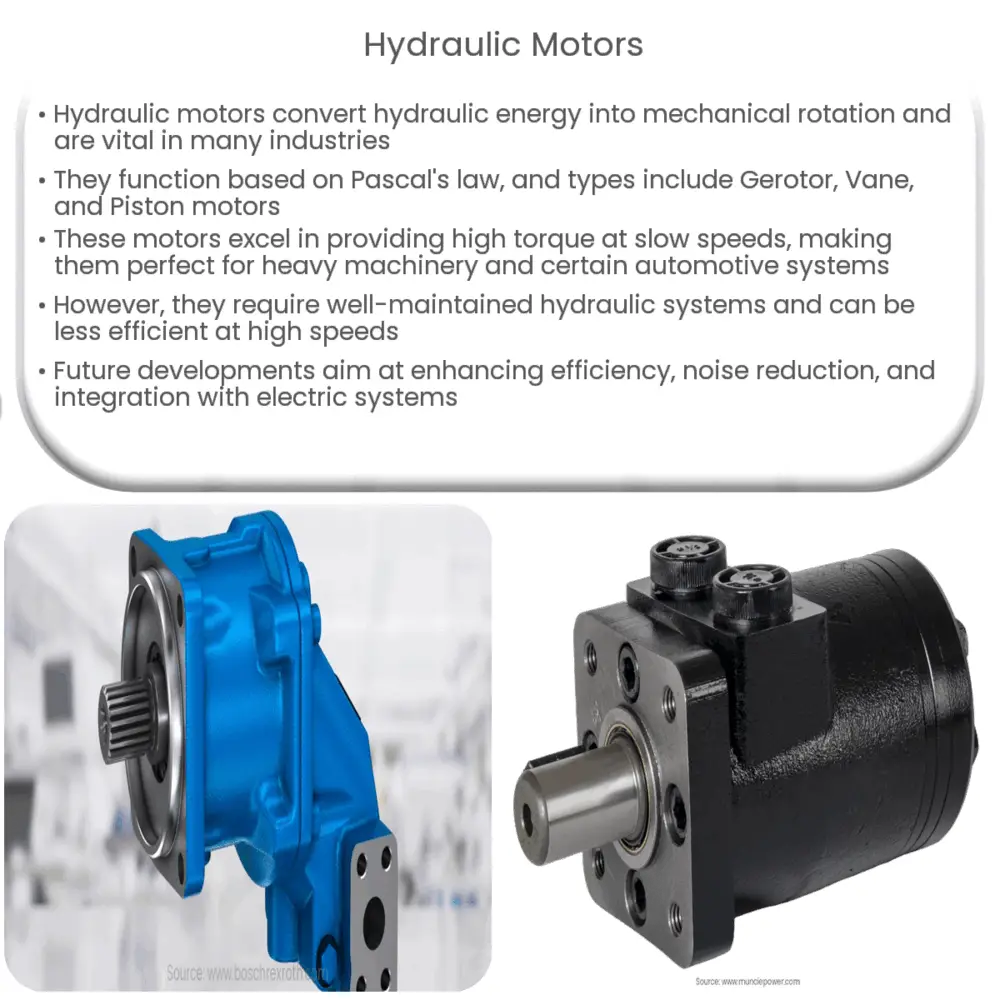Explore the world of hydraulic motors, their types, workings, advantages, and future developments in our comprehensive guide.

Understanding Hydraulic Motors
Hydraulic motors, an essential part of hydraulic systems, have diverse applications across many industries due to their unique properties and characteristics. To comprehend their function, we must first understand what hydraulics entail.
Hydraulics involves the use of pressurized fluids, typically oil, to transmit power in machines. The primary components in hydraulic systems include the hydraulic pump, valves, actuators, and the hydraulic motor. The latter plays a significant role in converting hydraulic energy (fluid power) into mechanical energy (rotation).
Types of Hydraulic Motors
- Gerotor Motors: These motors function by having an inner and outer rotor, with the inner rotor offset within the outer. This offset creates chambers that trap fluid, which is then expelled, causing the rotors to turn.
- Vane Motors: They employ vanes that slide in and out of the rotor to trap fluid, generating rotation.
- Piston Motors: In this type, pistons move back and forth inside the cylinder block. Their movement is caused by the hydraulic fluid, resulting in the rotation of the motor’s output shaft.
How Hydraulic Motors Work
A hydraulic motor works based on Pascal’s law which states that when pressure is applied to a fluid in a closed system, the pressure is equally distributed throughout the fluid1. This is how fluid power is converted to mechanical power.
When hydraulic fluid is pumped into the motor at high pressure, it enters chambers within the motor. As these chambers fill, they create forces that move internal parts of the motor, typically rotors or pistons. As the rotor or pistons move, they turn the output shaft, generating torque and causing rotation.
The movement of these internal parts creates new chambers on the opposite side of the motor. These chambers are then filled with fluid that has been pushed out from the first set of chambers. The cycle then repeats, maintaining a continuous motion.
Applications of Hydraulic Motors
Hydraulic motors find extensive use due to their high torque output at slow speeds, a desirable characteristic for many industrial applications. They are used in heavy machinery like excavators, cranes, and lifts, where substantial power is required.
In the automotive industry, hydraulic motors are used in braking systems, power steering systems, and in some types of transmissions. Due to their robustness and efficiency, they are also preferred in industries like mining, agriculture, construction, and manufacturing.
To be continued…
Advantages and Disadvantages of Hydraulic Motors
Like any technology, hydraulic motors come with their set of pros and cons.
- Advantages: Their standout advantages include their impressive torque-to-weight ratio, which enables them to generate high torque while remaining compact and light. They also operate well at low speeds and can even manage a ‘stall’ condition without damage. Furthermore, hydraulic motors are durable and resistant to harsh operating conditions, which makes them ideal for heavy-duty industrial applications.
- Disadvantages: On the downside, hydraulic motors require a clean and well-maintained hydraulic system to function effectively. Contamination of the hydraulic fluid can cause significant damage. They are also less efficient at high rotational speeds compared to electric motors and can be noisier.
Understanding Hydraulic Motor Efficiency
Efficiency in hydraulic motors is typically broken down into volumetric efficiency and mechanical efficiency. Volumetric efficiency1 refers to the ability of the motor to convert the flow of hydraulic fluid into output speed. Mechanical efficiency2, on the other hand, is the conversion of the hydraulic fluid pressure into output torque.
The Future of Hydraulic Motors
As we look forward, we can expect continued advancements in hydraulic motor technology. Engineers and researchers are constantly seeking ways to improve efficiency, reduce noise, and increase the lifespan of these motors. Emerging trends include the use of more advanced materials, incorporation of smart technology for improved diagnostics, and integration with electric systems in hybrid designs.
Conclusion
In conclusion, hydraulic motors are a vital element in numerous applications across multiple industries. Their ability to convert hydraulic power into mechanical energy with high torque and at low speeds make them an indispensable part of many heavy-duty machines and systems. While they have certain disadvantages such as the necessity for clean hydraulic systems and potential noise issues, ongoing technological advances are steadily mitigating these drawbacks. With an eye to the future, we can anticipate the continued evolution of hydraulic motors, promising further benefits to various industries and applications.

